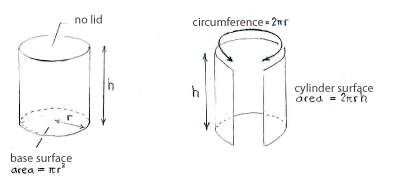Lösung 1.3:6
Aus Online Mathematik Brückenkurs 2
K |
K (Robot: Automated text replacement (-{{Displayed math +{{Abgesetzte Formel)) |
||
| Zeile 1: | Zeile 1: | ||
If we call the radius of the metal can ''r'' and its height ''h'', then we can determine the can's volume and area by using the figures below, | If we call the radius of the metal can ''r'' and its height ''h'', then we can determine the can's volume and area by using the figures below, | ||
| - | {{ | + | {{Abgesetzte Formel||<math>\begin{align} |
\text{Volume} &= \text{(area of the base)}\cdot\text{(height)}\\[5pt] | \text{Volume} &= \text{(area of the base)}\cdot\text{(height)}\\[5pt] | ||
&= \pi r^2\cdot h\,,\\[10pt] | &= \pi r^2\cdot h\,,\\[10pt] | ||
| Zeile 14: | Zeile 14: | ||
From the formula for the volume, we can make ''h'' the subject, | From the formula for the volume, we can make ''h'' the subject, | ||
| - | {{ | + | {{Abgesetzte Formel||<math>h=\frac{V}{\pi r^2}</math>}} |
and express the area solely in terms of the radius, ''r'', | and express the area solely in terms of the radius, ''r'', | ||
| - | {{ | + | {{Abgesetzte Formel||<math>A = \pi r^2 + 2\pi r\cdot\frac{V}{\pi r^2} = \pi r^2 + \frac{2V}{r}\,\textrm{.}</math>}} |
The minimisation problem is then: | The minimisation problem is then: | ||
| Zeile 28: | Zeile 28: | ||
The derivative is given by | The derivative is given by | ||
| - | {{ | + | {{Abgesetzte Formel||<math>A'(r) = 2\pi r - \frac{2V}{r^2}\,,</math>}} |
and if we set the derivative equal to zero, so as to obtain the critical points, we get | and if we set the derivative equal to zero, so as to obtain the critical points, we get | ||
| - | {{ | + | {{Abgesetzte Formel||<math>\begin{align} |
& 2\pi r - \frac{2V}{r^2} = 0\quad \Leftrightarrow \quad 2\pi r = \frac{2V}{r^2}\\[5pt] | & 2\pi r - \frac{2V}{r^2} = 0\quad \Leftrightarrow \quad 2\pi r = \frac{2V}{r^2}\\[5pt] | ||
&\quad\Leftrightarrow \quad r^3=\frac{V}{\pi}\quad \Leftrightarrow \quad r=\sqrt[\scriptstyle 3]{\frac{V}{\pi}}\,\textrm{.} | &\quad\Leftrightarrow \quad r^3=\frac{V}{\pi}\quad \Leftrightarrow \quad r=\sqrt[\scriptstyle 3]{\frac{V}{\pi}}\,\textrm{.} | ||
| Zeile 39: | Zeile 39: | ||
For this value of ''r'', the second derivative, | For this value of ''r'', the second derivative, | ||
| - | {{ | + | {{Abgesetzte Formel||<math>A''(r) = 2\pi + \frac{4V}{r^3}\,,</math>}} |
has the value | has the value | ||
| - | {{ | + | {{Abgesetzte Formel||<math>A''\bigl(\sqrt[3]{V/\pi}\bigr) = 2\pi + \frac{4V}{V/\pi } = 6\pi > 0\,,</math>}} |
which shows that <math>r=\sqrt[3]{V/\pi}</math> is a local minimum. | which shows that <math>r=\sqrt[3]{V/\pi}</math> is a local minimum. | ||
| Zeile 54: | Zeile 54: | ||
The metal can has the least area for a given volume <math>V</math> when | The metal can has the least area for a given volume <math>V</math> when | ||
| - | {{ | + | {{Abgesetzte Formel||<math>\begin{align} |
r &= \sqrt[3]{V/\pi}\,,\quad\text{and}\\[5pt] | r &= \sqrt[3]{V/\pi}\,,\quad\text{and}\\[5pt] | ||
h &= \frac{V}{\pi r^{2}} = \frac{V}{\pi}\Bigl(\frac{V}{\pi}\Bigr)^{-2/3} = \Bigl( \frac{V}{\pi}\Bigr)^{1-2/3} = \Bigl(\frac{V}{\pi}\Bigr)^{1/3} = \sqrt[3]{\frac{V}{\pi}}\,\textrm{.} | h &= \frac{V}{\pi r^{2}} = \frac{V}{\pi}\Bigl(\frac{V}{\pi}\Bigr)^{-2/3} = \Bigl( \frac{V}{\pi}\Bigr)^{1-2/3} = \Bigl(\frac{V}{\pi}\Bigr)^{1/3} = \sqrt[3]{\frac{V}{\pi}}\,\textrm{.} | ||
\end{align}</math>}} | \end{align}</math>}} | ||
Version vom 12:57, 10. Mär. 2009
If we call the radius of the metal can r and its height h, then we can determine the can's volume and area by using the figures below,
| \displaystyle \begin{align}
\text{Volume} &= \text{(area of the base)}\cdot\text{(height)}\\[5pt] &= \pi r^2\cdot h\,,\\[10pt] \text{Area} &= \text{(area of the base)} + \text{(area of the cylindrical surface)}\\[5pt] &= \pi r^2 + 2\pi rh\,\textrm{.} \end{align} |
The problem can then be formulated as: minimise the can's area, \displaystyle A = \pi r^2 + 2\pi h, whilst at the same time keeping the volume, \displaystyle V = \pi r^2h\,, constant.
From the formula for the volume, we can make h the subject,
| \displaystyle h=\frac{V}{\pi r^2} |
and express the area solely in terms of the radius, r,
| \displaystyle A = \pi r^2 + 2\pi r\cdot\frac{V}{\pi r^2} = \pi r^2 + \frac{2V}{r}\,\textrm{.} |
The minimisation problem is then:
- Minimise the area \displaystyle A(r) = \pi r^2 + \frac{2V}{r}, when \displaystyle r>0\,.
The area function \displaystyle A(r) is differentiable for all \displaystyle r>0 and the region of definition \displaystyle r>0 has no endpoints (\displaystyle r=0 does not satisfy \displaystyle r>0), so the function can only assume extreme values at critical points.
The derivative is given by
| \displaystyle A'(r) = 2\pi r - \frac{2V}{r^2}\,, |
and if we set the derivative equal to zero, so as to obtain the critical points, we get
| \displaystyle \begin{align}
& 2\pi r - \frac{2V}{r^2} = 0\quad \Leftrightarrow \quad 2\pi r = \frac{2V}{r^2}\\[5pt] &\quad\Leftrightarrow \quad r^3=\frac{V}{\pi}\quad \Leftrightarrow \quad r=\sqrt[\scriptstyle 3]{\frac{V}{\pi}}\,\textrm{.} \end{align} |
For this value of r, the second derivative,
| \displaystyle A''(r) = 2\pi + \frac{4V}{r^3}\,, |
has the value
| \displaystyle A''\bigl(\sqrt[3]{V/\pi}\bigr) = 2\pi + \frac{4V}{V/\pi } = 6\pi > 0\,, |
which shows that \displaystyle r=\sqrt[3]{V/\pi} is a local minimum.
Because the region of definition, \displaystyle r>0, is open (the endpoint \displaystyle r=0\text{ } is not included) and unlimited, we cannot directly say that the area is least when \displaystyle r = \sqrt[3]{V/\pi}\,; it could be the case that area becomes smaller when \displaystyle r\to 0 or \displaystyle r\to \infty . In this case, however, the area increases without bound as \displaystyle r\to 0 or \displaystyle r\to \infty , so \displaystyle r=\sqrt[3]{V/\pi} really is a global minimum.
The metal can has the least area for a given volume \displaystyle V when
| \displaystyle \begin{align}
r &= \sqrt[3]{V/\pi}\,,\quad\text{and}\\[5pt] h &= \frac{V}{\pi r^{2}} = \frac{V}{\pi}\Bigl(\frac{V}{\pi}\Bigr)^{-2/3} = \Bigl( \frac{V}{\pi}\Bigr)^{1-2/3} = \Bigl(\frac{V}{\pi}\Bigr)^{1/3} = \sqrt[3]{\frac{V}{\pi}}\,\textrm{.} \end{align} |

